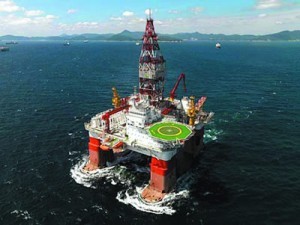Iranian Ship Linked to Houthi Attacks Heads Home Amid Tensions
(Bloomberg) — An Iranian ship that’s been linked to Houthi attacks in the Red Sea is returning home, removing a prominent asset in the area as the Islamic Republic braces...


HONG KONG, May 6 (Reuters) – The United States said on Tuesday it was investigating the movement of a huge Chinese oil rig that Vietnam says has entered its waters, the latest show of Beijing’s growing assertiveness to raise alarm among smaller countries in the region.
The Vietnamese accusation came days after U.S. President Barack Obama visited Asia to underline his commitment to allies there, including Japan and the Philippines who are themselves locked in territorial disputes with China.
Obama, promoting a strategic “pivot” toward the Asia-Pacific region, also visited South Korea and Malaysia, but not China.
Vietnam has condemned the operation of the deepwater drilling rig in what it says are its waters in the South China Sea and told China’s state-run oil company to remove it. China said the rig was operating completely within its waters.
Daniel Russel, Assistant U.S. Secretary of State for East Asian and Pacific Affairs, said the United States was looking into the matter, but urged caution from all sides.
“We believe that it is critically important for each of the claimant countries to exercise care and restraint,” he told Reuters during a visit to Hong Kong ahead of a previously scheduled trip to Hanoi on Wednesday.
“The global economy is too fragile and regional stability is too important to be put at risk over short term economic advantage.”
China claims almost the entire oil- and gas-rich South China Sea, rejecting rival claims to parts of it from Vietnam, the Philippines, Taiwan, Malaysia and Brunei. It also has a separate maritime dispute with Japan.
EXCLUSION ZONE
Its claims coincide with growing diplomatic and military influence in the region and have raised fears of possible conflict.
The Maritime Safety Administration of China (MSAC) announced on its website on Saturday that all vessels should keep one mile (1.6 km) away from the rig, called the Haiyang Shiyou 981. It expanded that to three miles on Monday.
The $1 billion rig is owned by China’s state-run CNOOC oil company and it had been drilling south of Hong Kong.
On Sunday, Vietnam’s Foreign Ministry spokesman objected to the Chinese announcement, saying the coordinates of the oil rig put it in Vietnam’s exclusive economic zone and on its continental shelf, about 120 nautical miles off its coast.
The spokesman, Le Hai Binh, said in a statement Vietnam “resolutely opposed” the Chinese company’s drilling.
But, like other Asian nations involved in territorial disputes with China, Vietnam appears to have limited options when dealing with the emerging superpower.
The Philippines said last month that the United States had a treaty obligation to help in case of an attack on its territory or armed forces in the South China Sea, although Obama did not say categorically that Washington would do so.
In 1992, Vietnam sent naval vessels into an area where China signed a contract with a U.S. firm to develop oil and gas in what it said were its waters.
“From 1992 until now, I haven’t seen any action from Vietnam stronger than that,” said a Vietnamese academic who specializes in South China Sea affairs.
“…My guess is either this action from China is to send a message to the United States after Obama’s Asia visit, or to direct the community to this topic to distract them from the terror in Xinjiang.”
China’s nervousness about Islamist militancy has grown since a car burst into flames on the edge of Beijing’s Tiananmen Square in October and 29 people were stabbed to death in March in the southwestern city of Kunming.
The government blamed militants from the far-western region of Xinjiang for both attacks.
China routinely sends patrols into the South China Sea, mostly involving the coast guard and civilian maritime protection force rather than the navy.
But the positioning of such a large structure in disputed waters was seen by some analysts as a significant escalation in the dispute.
Singapore-based South China Sea expert Ian Storey said the rig movement risked a “potentially very dangerous scenario”.
“There have been standoffs with survey ships in the past, but this is something new,” said Storey of the Institute of South East Asian Studies.
“There’s been a great deal of speculation about how China would use this expensive new rig and it seems we now have the answer. It puts Vietnam in a very difficult position.
“They will have to respond to a challenge to their sovereignty, and when they do, China will be sure to make a counter move, so we are in a situation where a potentially very dangerous scenario could unfold.”
China’s Global Times, an influential tabloid published by the ruling Communist Party’s official People’s Daily, wrote in an editorial on Tuesday that China should show a “firm attitude” towards Vietnam.
“China follows a moderate policy. But no country can always show a smiling face to the world. China shouldn’t be angered easily, but if its interests are infringed upon, a strong retaliatory move should be expected,” it said. (Additional reporting by Nguyen Phuong Linh in Hanoi and Ben Blanchard in Beijing; Writing by Nick Macfie; Editing by Mike Collett-White)
Join the gCaptain Club for curated content, insider opinions, and vibrant community discussions.


Join the 105,982 members that receive our newsletter.
Have a news tip? Let us know.
Access exclusive insights, engage in vibrant discussions, and gain perspectives from our CEO.
Sign Up




Maritime and offshore news trusted by our 105,982 members delivered daily straight to your inbox.



Essential news coupled with the finest maritime content sourced from across the globe.
Sign Up